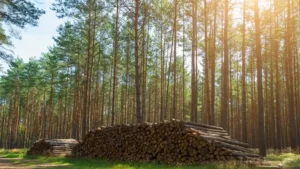Forestry Investment Opportunities: Simple Ways to Invest
- August 15, 2024
- 0 comment
Forestry investment opportunities are an often-overlooked asset class that presents unique opportunities for both financial growth and environmental sustainability. As global awareness of climate change and environmental degradation increases, more investors are seeking sustainable and alternative investment options. Forestry investment opportunities, which involve the management and cultivation of forests for timber and other products, stand out as a viable choice.
It not only promises potential financial returns but also plays a crucial role in promoting biodiversity, carbon sequestration, and responsible land use. Investing in forestry can take various forms, from direct ownership of timberland to participation in timber investment management organizations (TIMOs) and real estate investment trusts (REITs). Each of these options offers different levels of involvement, risk, and potential returns, making it essential for investors to understand the landscape before diving in.
List of Forestry Investment Opportunities:
- Understanding Forestry Investment Opportunities
- Types of Forestry Investment Opportunities
- Benefits of Forestry Investments
- Risks Associated with Forestry Investments
- Evaluating Forestry Investments
- How to Start Investing in Forestry
- Timberland Ownership: Pros and Cons
- TIMOs and How They Work
- Investing in Forestry REITs
- Environmental Impact of Forestry Investments
- Tax Implications of Forestry Investments
- Future Trends in Forestry Investments
Understanding Forestry Investment Opportunities

Forestry investment encompasses the management and cultivation of forests for timber production and other forest products. This can include activities such as planting, maintaining, and harvesting trees, as well as managing the land for ecological health and sustainability. Investors can engage in forestry through direct ownership of timberland, participation in TIMOs, or investing in forestry-related REITs.
Investing in forestry is crucial for several reasons, including sustainable resource management, economic stability, and portfolio diversification. Forestry investments promote sustainable land use, contribute to carbon sequestration, and provide a steady supply of materials for construction and other industries. Additionally, forestry investments offer low correlation with traditional asset classes like stocks and bonds, enhancing overall portfolio stability.
Types of Forestry Investment Opportunities
- Timberland Ownership: Directly purchasing and managing forested land allows investors to control the management practices and harvest schedules. This option requires significant capital and expertise but offers the highest potential returns.
- Timber Investment Management Organizations (TIMOs): These are professional firms that manage timberland on behalf of investors. They pool capital from multiple investors to acquire and manage forests, providing access to forestry investments without the need for direct ownership.
- Real Estate Investment Trusts (REITs): Timber REITs are publicly traded companies that own and manage forests. Investors can buy shares in these REITs, providing liquidity and diversification within the forestry sector.
Benefits of Forestry Investments
Investing in forestry can provide several benefits. Firstly, it supports sustainable practices that help protect the environment. By promoting biodiversity, protecting watersheds, and sequestering carbon, forestry investments contribute positively to the planet. Additionally, forestry investments can yield substantial financial returns over time.

.As trees mature, timber prices tend to appreciate, and investors can profit from both timber sales and land value appreciation. Historical data shows that forestry has outperformed many traditional asset classes in the long run. Finally, forestry investments typically exhibit low correlation with other asset classes, providing a hedge against market volatility and enhancing the stability of an investor’s overall portfolio.
Risks Associated with Forestry Investments
Market Fluctuations
Timber prices can change due to various factors, which can affect how much money investors make. Economic conditions, such as a recession, can lower demand for timber and forest products, leading to decreased prices. Additionally, competition from alternative materials, like steel or plastic, can also impact timber sales. Investors need to pay attention to these market changes and understand how they might influence their returns. By staying informed about market trends, investors can make better decisions and adjust their strategies accordingly.

Natural Disasters
Forests are at risk from natural disasters like wildfires, storms, and pest infestations. These events can cause significant damage to trees, which can reduce the amount of timber available for sale and lower land value. For example, a severe storm can knock down many trees, making it difficult to harvest timber in the affected area.
Effective management practices are vital to reduce these risks. This includes preparing for potential disasters by maintaining healthy forests and having plans in place to respond quickly when disasters occur. By being proactive, investors can help protect their investments from the negative impacts of natural disasters.

Regulatory Risks
Changes in laws and regulations can also affect forestry investments. For instance, new environmental rules may limit how much timber can be harvested or require additional permits for land use. Investors should keep themselves updated on relevant laws and policies that could impact their investments. Understanding these regulations is essential for making informed decisions and ensuring compliance, which can help prevent unexpected costs or losses. By staying informed, investors can better navigate the challenges posed by changing regulations in the forestry sector.

Evaluating Forestry Investments
Due Diligence
Conducting thorough due diligence is essential before investing in forestry. This means carefully checking various factors to ensure a wise investment. Investors should assess the quality of the timber, looking at the types of trees and their health. They also need to evaluate the overall health of the forest ecosystem, which includes examining the soil, water sources, and wildlife present.
Additionally, it is important to review the management practices in place. Good management practices ensure that the forest is being cared for properly, which can lead to better growth and higher returns. By taking the time to conduct this thorough evaluation, investors can reduce risks and make more informed decisions.
Financial Performance Metrics
Investors should analyze key financial metrics to understand the potential profitability of forestry investments. Important metrics include the internal rate of return (IRR), which helps measure the expected annual growth rate of the investment, and the net present value (NPV), which calculates the current value of future cash flows from the investment.
Additionally, cash flow projections are crucial as they show how much money the investment is expected to generate over time. By examining these financial performance metrics, investors can gain insights into the expected returns and make better decisions about their forestry investments. Understanding these numbers helps investors compare forestry investments with other opportunities and assess their overall financial viability.
How to Start Investing in Forestry
If you’re interested in investing in forestry, there are several steps you can take to get started:

Identifying Investment Opportunities
Begin by researching the available forestry investment options in your area. This includes looking for timberland properties that are for sale, as well as exploring timber investment management organizations (TIMOs) and forestry real estate investment trusts (REITs).TIMOs are firms that manage timberland investments on behalf of investors, while REITs are publicly traded companies that own and manage forests. Both offer ways to invest in forestry without directly owning land.
Assessing Your Investment Goals
Before making any decisions, take the time to clearly define your investment goals, risk tolerance, and time horizon. This will help you determine the most suitable forestry investment type for your needs.Consider factors like:
- How much capital you have to invest
- Your desired level of involvement in managing the investment
- Your target returns and time frame
- Your risk appetite
Choosing the Right Investment Type
Based on your assessment, decide whether to invest directly in timberland, through a TIMO, or via a REIT:
- Direct timberland ownership provides the most control but requires significant capital and expertise. It’s best suited for investors with substantial resources and forestry knowledge.
- Investing through a TIMO allows you to access professional management and a diversified portfolio of timberland assets. TIMOs typically cater to institutional investors with large sums to invest.
- Buying shares in a forestry REIT is a liquid way to gain exposure to forestry without direct ownership. It’s a good option for individual investors looking for an easy entry point.
Whichever route you choose, be sure to conduct thorough due diligence on the specific investment, including assessing the quality of the timber, the health of the forest ecosystem, and the management practices in place. Analyzing key financial metrics like internal rate of return (IRR) and net present value (NPV) can also help evaluate the investment’s potential profitability.
By following these steps and carefully considering your options, you can make an informed decision about how to start investing in forestry in a way that aligns with your goals and risk tolerance. Consulting with a financial advisor who specializes in alternative investments can provide additional guidance as you navigate this process.
Timberland Ownership: Pros and Cons
Advantages
- Control: Direct ownership allows for complete control over management practices and harvest schedules.
- Tax Benefits: Timberland investments can provide significant tax advantages, including exemptions from income and capital gains taxes in some jurisdictions.
Disadvantages
- High Capital Requirement: Purchasing timberland typically requires substantial upfront investment.
- Management Responsibility: Investors must be prepared to manage the land or hire professionals, which can be time-consuming and costly.
TIMOs and How They Work
Timber Investment Management Organizations (TIMOs) are specialized firms that manage timberland investments for investors. These organizations bring expertise in forest management, allowing them to optimize returns through strategic harvesting and effective land management practices. By leveraging their knowledge of the forestry sector, TIMOs can help investors navigate the complexities of timberland ownership while maximizing the value of their investments.
TIMOs use a variety of investment strategies to achieve their goals. They often focus on acquiring undervalued timberland, which can provide significant upside potential. Additionally, TIMOs implement sustainable management practices to ensure the long-term health of the forests they manage. This includes careful planning to maximize timber yields while maintaining ecological balance. By combining these strategies, TIMOs aim to deliver strong financial returns while promoting responsible forestry practices.
Investing in Forestry REITs
Overview of REITs
Forestry REITs are publicly traded companies that own and manage forests. They generate revenue through timber sales and other forest products, providing investors with a liquid way to invest in forestry.
Benefits and Drawbacks
- Benefits: REITs offer liquidity, diversification, and the potential for regular dividends.
- Drawbacks: Investors may have less control over management decisions and may be subject to market volatility.
Environmental Impact of Forestry Investments
Investing in sustainable forestry is important because it helps protect forest ecosystems while still generating economic returns. Sustainable practices, such as selective logging and reforestation, allow for the careful harvesting of trees without harming the overall health of the forest. These methods support biodiversity by preserving various plant and animal species and maintaining the balance of the ecosystem.

By focusing on sustainability, investors can contribute to the long-term health of forests while also benefiting financially. Forestry investments also play a vital role in carbon sequestration, which is the process of absorbing carbon dioxide from the atmosphere. Trees naturally take in carbon dioxide as they grow, helping to reduce greenhouse gases and combat climate change.
By investing in forestry, individuals and organizations can support efforts to mitigate climate change while also enjoying the financial rewards that come from managing and harvesting timber sustainably. This dual benefit makes forestry investments an attractive option for environmentally conscious investors.
Tax Implications of Forestry Investments
Tax Incentives
Investors in forestry can take advantage of several tax incentives that can significantly reduce their tax burden. One of the main benefits is the exemption from income tax on timber revenue. This means that when you sell timber, the money you earn may not be subject to the same high tax rates as regular income. Instead, it may qualify for capital gains tax rates, which are generally lower.
To benefit from this, investors must hold the timber for at least one year before selling it. Additionally, in some regions, forestry investments may also qualify for inheritance tax relief, allowing for a smoother transfer of assets to heirs without incurring heavy tax penalties. It’s important for investors to understand the specific tax rules in their area, as they can vary widely.
For example, some states have programs that offer tax breaks for landowners who commit to sustainable forestry practices or maintain a forest management plan. Consulting with a tax professional who specializes in forestry can help investors navigate these incentives and maximize their financial benefits.
Reporting and Compliance
Investors should also be aware of the reporting requirements and compliance obligations associated with forestry investments. These requirements can differ depending on the jurisdiction, so it’s crucial to stay informed about local laws. When selling timber, it is necessary to report the income accurately to avoid penalties.
For instance, timber buyers often provide 1099 forms to report the income, and failing to report this income can lead to legal issues. Additionally, investors may need to complete specific tax forms, such as Form T (Timber) for reporting timber-related activities and deductions. Keeping detailed records of all transactions, expenses, and timber sales is essential for ensuring compliance and making the tax filing process smoother.
By understanding these reporting requirements and maintaining good records, investors can effectively manage their tax obligations while focusing on the growth and profitability of their forestry investments.
Future Trends in Forestry Investments
Technological Advances
The future of forestry investments is looking bright, thanks to new technologies that are making forest management smarter and more efficient. Tools like remote sensing, which uses satellites to monitor forest health, and data analytics, which helps in making informed decisions, are becoming more common. These advancements allow investors to track their forests better and improve the way they manage them, leading to higher profits and healthier forests. By using technology, forestry investments can become more effective, ensuring that both the environment and investors benefit.

Market Predictions
Market predictions also suggest that the demand for sustainable timber and forest products will keep rising. As more people become aware of climate change and seek eco-friendly options, the interest in forestry investments is expected to grow. This trend opens up new opportunities for investors who want to be part of a market that not only aims for financial success but also supports environmental health. With the combination of technology and increasing demand, the forestry investment sector is poised for significant growth in the coming years.

Conclusion
Forestry investment opportunities offer a compelling blend of financial returns and environmental benefits. As global awareness of sustainability grows, the demand for responsible and profitable investment options like forestry is set to rise. From direct timberland ownership to investing through TIMOs and REITs, there are multiple ways to engage in forestry investments, each with its unique advantages and challenges.
By understanding the landscape, conducting thorough due diligence, and aligning investment choices with personal goals and risk tolerance, investors can tap into the promising potential of forestry. As technological advancements and market trends continue to evolve, forestry investments will likely play an increasingly vital role in both economic and ecological landscapes.
Frequently Asked Questions
1. What are the main types of forestry investments?
The main types of forestry investments include direct timberland ownership, Timber Investment Management Organizations (TIMOs), and Real Estate Investment Trusts (REITs). Each option offers varying levels of involvement, risk, and potential returns.
2. How do forestry investments benefit the environment?
Forestry investments support sustainable forest management practices, which help conserve biodiversity, protect water resources, and sequester carbon. These environmental benefits contribute to climate change mitigation and ecological health.
3. What are the financial benefits of investing in forestry?
Investing in forestry can yield substantial financial returns through timber sales and land value appreciation. Forestry investments also offer diversification benefits, as they are generally uncorrelated with traditional asset classes like stocks and bonds.
4. What are the risks associated with forestry investments?
Risks include market fluctuations in timber prices, natural disasters like wildfires and storms, and regulatory changes that can impact land use and timber harvesting. Investors must be prepared for these potential challenges.
5. How can I start investing in forestry?
To start investing in forestry, research available investment opportunities, assess your investment goals and risk tolerance, and choose the right investment type—whether it be direct ownership, TIMOs, or REITs. Conduct thorough due diligence on the specific investment.
6. What are TIMOs and how do they work?
TIMOs (Timber Investment Management Organizations) are firms that manage timberland investments on behalf of investors. They pool capital to acquire and manage forests, optimizing returns through strategic harvesting and sustainable management practices.
7. What are the advantages and disadvantages of owning timberland?
Advantages of owning timberland include direct control over management practices and potential tax benefits. Disadvantages include high capital requirements, management responsibilities, and exposure to market volatility and natural disasters.
8. How do forestry REITs provide investment opportunities?
Forestry REITs are publicly traded companies that own and manage forested lands. They offer investors liquidity, diversification, and potential dividends from timber sales and land leases, but with less control over management decisions.
9. What tax incentives are available for forestry investments?
Forestry investments can qualify for tax incentives such as income tax exemptions on timber revenue, capital gains tax benefits, and inheritance tax relief. These incentives vary by region, so consulting with a tax professional is advisable.
10. What are the future trends in forestry investments?
Future trends in forestry investments include technological advancements in forest management, increasing demand for sustainable timber, and growing market interest in eco-friendly investment options. These trends are expected to enhance the profitability and sustainability of forestry investments.
We hope this exploration of forestry investment opportunities has provided valuable insights into the potential for financial growth and environmental sustainability in this unique asset class. Understanding the various ways to invest in forestry, along with the associated benefits and risks, is crucial for making informed decisions. If you have any experiences or additional thoughts on forestry investment opportunities, please share them in the comments below. Your input can help others appreciate the significance of sustainable forestry investments and their role in promoting both economic and ecological well-being. Don’t forget to share this article with friends and colleagues who are interested in forestry to expand the conversation and highlight the importance of sustainable forestry practices.

James Wilson
Forestry AuthorJames Wilson has over 15 years of experience in forestry economics, specializing in sustainable practices, investment opportunities, and financial management. He has contributed to notable publications like "Forestry Today" and "EcoFinance Journal" and is known for providing practical and insightful advice. With a degree in Environmental Economics, James stays updated through continuous learning and active participation in industry discussions. Outside work, he enjoys hiking and nature photography, bringing a well-rounded perspective to his professional role.












Leave your comment